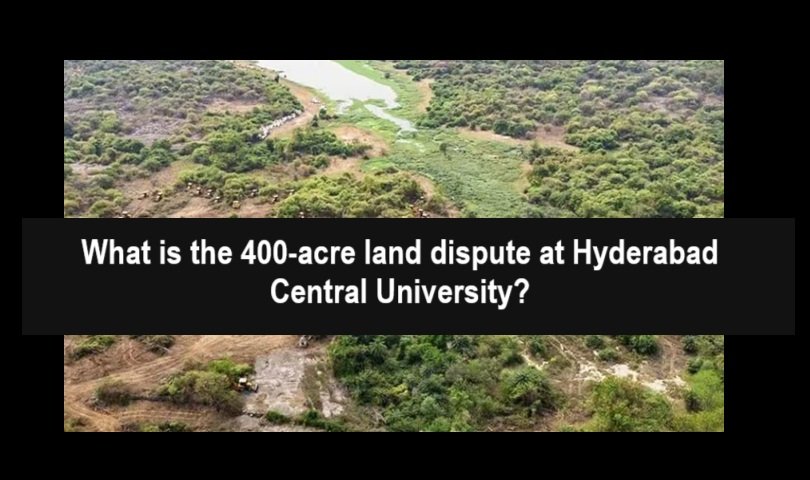
The Telangana government’s decision to clear approximately 400 acres of land in Kancha Gachibowli, a region adjacent to the University of Hyderabad (commonly referred to as Hyderabad Central University or HCU), has ignited a firestorm of protests, legal battles, and political debates. This contentious move, aimed at auctioning the land for industrial and infrastructural development, has pitted the state government against students, environmentalists, and opposition parties. At the heart of the controversy lies a clash between economic development and environmental preservation, with the HCU community playing a pivotal role in amplifying the issue. As of April 3, 2025, the situation remains fluid, with recent court interventions and ongoing protests shaping the narrative. This article provides an in-depth exploration of the matter, tracing its origins, detailing the involvement of HCU, and presenting the latest updates.
Background: The Land in Question
The 400 acres of land in Kancha Gachibowli, located in Hyderabad’s burgeoning IT corridor within Rangareddy district, have long been a subject of dispute. The Telangana government asserts that this parcel is state-owned, a claim bolstered by legal victories in both the Telangana High Court and the Supreme Court. According to official statements, the land was originally allotted in 2004 by the then-united Andhra Pradesh government to IMG Academies Bharat Private Limited for sports infrastructure development. However, the company failed to initiate the project, leading to the cancellation of the allotment in 2006. The land was subsequently reassigned to the Andhra Pradesh Youth Advancement, Tourism, and Cultural Department. After years of legal wrangling, the Telangana government secured ownership in May 2024 following a Supreme Court ruling, paving the way for its current plans.
The state envisions transforming this land into a hub of world-class infrastructure, including IT parks, urban living spaces, and enhanced connectivity. The proposed auction is expected to generate between ₹10,000 and ₹15,000 crore, with potential investments reaching ₹50,000 crore once fully operational. The Telangana Industrial Infrastructure Corporation (TGIIC) has been tasked with overseeing the development, promising to preserve notable geological features like the Mushroom Rock and integrate green spaces into the layout. However, this vision has met fierce resistance from those who view the land as an ecological treasure.
Ecological Significance and HCU’s Connection
The Kancha Gachibowli area is not just a piece of real estate; it is widely regarded as one of Hyderabad’s last remaining “green lungs” in the western part of the city. A 2008-09 joint study by the University of Hyderabad and the World Wide Fund for Nature (WWF)-India documented over 455 species of flora and fauna in the region, including herbs, shrubs, creepers, butterflies, birds, and mammals. The area is home to Schedule-I protected species under the Wildlife (Protection) Act, such as peacocks, spotted deer, wild boars, and star tortoises, as well as unique rock formations and two lakes—Buffalo Lake and Peacock Lake. Environmentalists argue that this biodiversity hotspot plays a critical role in regulating the local climate, absorbing pollutants, and recharging groundwater in an increasingly urbanized Hyderabad.
HCU’s involvement stems from both its proximity to the land and its academic focus on biodiversity and environmental studies. The university, established in 1975 with an initial allocation of 2,324 acres, claims that the 400 acres in question were part of its original endowment. However, the state government and court rulings have refuted this, asserting that no legal deed confirms the transfer of this specific parcel to HCU. Despite this, the university community—students, faculty, and staff—has rallied to protect the land, viewing it as an extension of their campus ecosystem and a vital resource for research and conservation. The HCU Students’ Union (HCUSU) and other student groups, such as the Students’ Federation of India (SFI), have been at the forefront of the protests, framing the issue as a fight for environmental justice and the university’s integrity.
The Spark: Protests Erupt
The controversy escalated in late March 2025 when TGIIC deployed bulldozers and earthmovers to begin clearing the land. On March 30, students and activists noticed heavy machinery and police presence at the site, prompting immediate action. Over 50 students rushed to obstruct the equipment, leading to clashes with the Cyberabad police. More than 50 individuals were detained, with two students, Rohit Kumar and Naveen Kumar, facing formal arrests on charges of unlawful assembly, rioting, and attacking public servants. The police denied allegations of excessive force, such as lathi charges or dragging students by their hair, claiming that the detained were released except for the two arrested individuals, whom they later clarified were no longer enrolled at HCU.
The clearance continued unabated through the night of March 30 and into March 31, with the number of excavators reportedly increasing from eight to over 50. Students estimated that 50 acres were leveled overnight, a pace that alarmed protesters who feared the rapid destruction of evidence of biodiversity ahead of an impending court hearing. The HCUSU launched an indefinite class boycott on April 1, staging sit-ins and large-scale demonstrations. Faculty and the teachers’ union joined the fray, with a protest march on April 2 turning violent as police used batons to disperse the crowd near the university’s east campus.
The Government’s Stance
The Telangana government, led by Chief Minister A. Revanth Reddy, has staunchly defended its actions. Official statements from the Chief Minister’s Office (CMO) and senior ministers, including Deputy Chief Minister Mallu Bhatti Vikramarka and Industry Minister D. Sridhar Babu, emphasize that the land is not classified as forest land in revenue or forest records but as “Kancha Poramboke” (grazing/waste land). They argue that any challenge to their ownership constitutes contempt of court, given the Supreme Court’s 2024 ruling. The government has accused opposition parties, notably the Bharat Rashtra Samithi (BRS) and the Bharatiya Janata Party (BJP), of misleading students for political gain and stoking unrest.
To address environmental concerns, TGIIC has pledged to preserve the Mushroom Rock and other rock formations, denying that lakes fall within the development zone. The government also claims that a joint boundary survey with HCU officials in July 2024 confirmed the university has no claim to the land. CM Reddy has dismissed the protests as politically motivated, famously calling BRS leaders “cunning foxes” in a March 26 Assembly speech, a remark that further inflamed tensions.
Legal Battles and Environmental Advocacy
The issue has reached the Telangana High Court, where multiple Public Interest Litigations (PILs) have been filed. The Vata Foundation, an environmental NGO, sought to declare the land a “deemed forest” under the Supreme Court’s 1996 T.N. Godavarman Thirumalapad ruling, which defines any land with forest cover as forest land, regardless of official notification. Another PIL by retired scientist K. Babu Rao and a petition by HCU students echoed this demand, arguing that the clearance violates the Forest Conservation Act and the Walta Act. Environmentalists, including the Save City Forest Collective, have criticized the lack of an Environmental Impact Assessment (EIA), warning that deforestation could raise local temperatures by 1-4°C and irreparably harm Hyderabad’s ecosystem.
On April 2, 2025, the Telangana High Court, presided over by Acting Chief Justice Sujoy Paul and Justice Renuka Yara, ordered an immediate halt to all clearing activities until the next hearing on April 3. This interim relief came after petitioners highlighted the ongoing destruction despite the pending litigation. The Advocate General, A. Sudarshan Reddy, countered that the land’s historical designation as “Kancha land” and its prior allocation to IMG Bharata in 2003 undermine claims of it being a reserved forest. The court’s decision on April 3 will be pivotal, though the matter is expected to extend beyond this date, with a related hearing scheduled for April 7.
Political Dimensions
The controversy has become a political lightning rod. The BRS, led by former Deputy Chief Minister K.T. Rama Rao, has accused the Congress government of “brazen green murder,” pointing to the destruction of Hyderabad’s last natural reserves. Rao has questioned the silence of Congress leader Rahul Gandhi, known for his environmental advocacy, and criticized the timing of the clearance during a court holiday period. The BJP, through Union Minister Bandi Sanjay, has demanded central intervention, citing Supreme Court directives against deforestation without approval. Meanwhile, the Congress has accused the BRS of hypocrisy, noting its own attempts to develop the land during its tenure.
Latest Updates as of April 3, 2025
As of today, April 3, 2025, at 2:00 AM PDT, the situation remains tense but paused due to the High Court’s order. The halt on clearing activities, effective until at least the afternoon hearing, has given protesters a temporary reprieve. HCU students and faculty continue their agitation, with plans for a “full-scale agitation” if the government resumes work. The police presence on campus remains heavy, and detained students have largely been released, though the two arrested individuals face ongoing legal proceedings.
The High Court’s hearing later today will determine the next steps, with petitioners pushing for a permanent injunction and the government defending its development agenda. Environmentalists and students are also calling for an independent ecological assessment, a demand the government has yet to address. Meanwhile, the Centre has sought a report from Telangana, signaling potential national oversight given the ecological and legal implications.
Broader Implications
The Kancha Gachibowli row encapsulates a broader dilemma: how to balance economic growth with environmental sustainability in rapidly urbanizing India. For Hyderabad, a city already grappling with pollution and shrinking green spaces, the loss of 400 acres could have lasting consequences. For HCU, the fight is personal—a defense of their academic mission and campus identity. As the legal and public battles unfold, the outcome will likely set a precedent for similar disputes across the country, making this a story worth watching closely in the days ahead.





